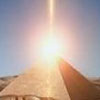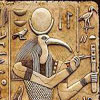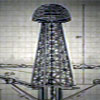Ancient Pyramids And Electricity
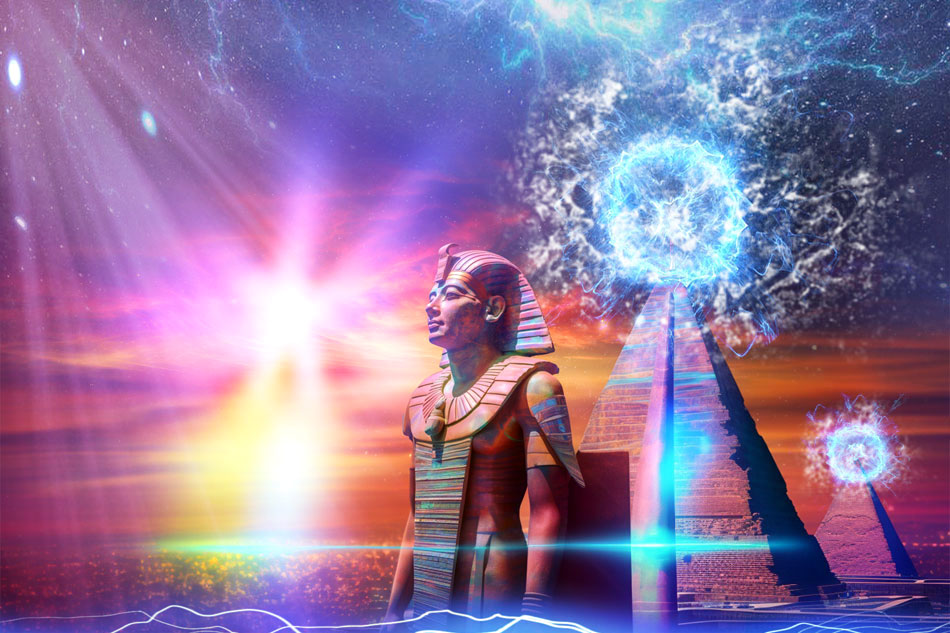 It may have been a Million years ago
It may have been a Million years ago
The Light was kindled in the Old Dark Land
Within which the illumined Scrolls are all aglow,
That Egypt gave us with her mummied hand:
This was the secret of that subtle smile
Inscrutable upon the Sphinx’s face,
Now told from sea to sea, from isle to isle;
The revelation of the Old Dark Race;
Theirs was the wisdom of the Bee and Bird,
Ant, Tortoise, Beaver, working human-wise;
The ancient darkness spake with Egypt’s Word;
Hers was the primal message of the skies:
The Heavens are telling nightly of her glory,
And for all time Earth echoes her great story. ~ Gerald Massey
![]()
 THE PYRAMIDS WERE GIANT POWER PLANTS
THE PYRAMIDS WERE GIANT POWER PLANTS
by Ranah
The outer casing of the Great Pyramid was covered with white tufa limestone, so tightly built that not even a razor blade could fit between the blocks. The white tufa limestone does not contain magnesium and has high insulating properties. This insulation property prevented the electricity inside the pyramid from being released without control.
The stone blocks used inside the pyramid were made of another form of limestone containing crystal which is an extremely high electrical conductor and a small amount of metal, which allowed for maximum power transmission. The shafts inside the pyramid were lined with granite. Granite, as a conductor, is a slightly radioactive substance and permits the ionization of the air inside these shafts.
When we look at an insulated electric cable, we see that conductive and insulation materials are used in the same way as in the pyramids.
The conductive and insulating properties of the pyramid are an example of flawless engineering. However, a source of energy is needed for electricity generation.
The Giza Plateau where the pyramids stand is full of underground water channels. The pyramids rise above limestone layers, the spaces between them being full of water. These special layers of rock that transmit electricity upward as they carry underground water to the surface are known as AQUIFERS. The high volume flow of the River Nile that passes through these aquifers produces an electric current. This is known as physio-electricity.
The pyramid’s underground chambers are granite conductors built within the rock charged with physio-electricity. This electric current is conducted directly to the upper part of the pyramid’s granite covered subterranean chambers. Granite is a very good conductor of electricity.
The electromagnetic field that forms at the bottom of the pyramid is transmitted in concentrated form to the upper layers of the pyramid. On the top of the pyramid there was a gold capstone, gold being an excellent conductor of electricity. This section is no longer there in our day. This means the top of the pyramid has lost its structure of flawless geometry. This gold capstone facilitated a conductive path for the transfer of negative ions to the ionosphere. This way a current was generated.
How does it serve to move the electromagnetic field on the ground through the help of an aquifer?
An identical form of this technology, employed in Egypt 5,000 years ago, was used by Nikola Tesla, an inventor of electric technology in the early 1900s, in a tower he constructed in the United States.
Tesla, the inventor of such fundamental electric technology as the alternating current, electric engine, radio, the laser and radar, was successful in simultaneously transmitting sound and pictures between continents in the Wardenclyffe tower he built between 1901 and 1917. He did not use an external source of electricity for this, and even applied wireless power transmission technology.
Tesla had also built his tower above an aquifer and discharged the negative ions from the aquifer to the tower. The electromagnetic technology used in Tesla’s famous tower is identical to the electromagnetic field set up in the construction of the pyramids. Both systems generate negative ions and transmit them without the need for electric cables.
So for what purpose did the Egyptians use electricity?
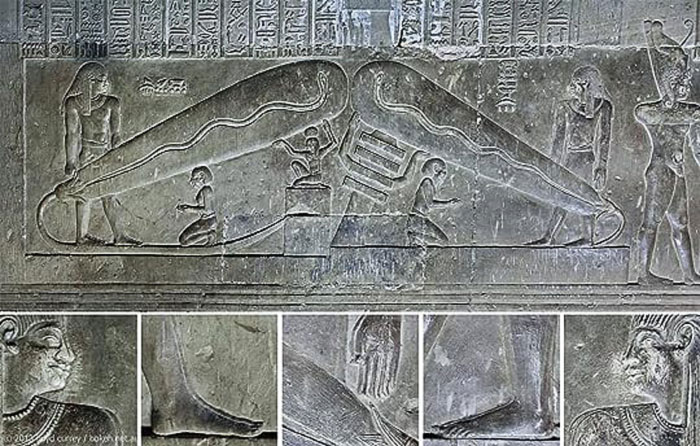 These bulbs are reminiscent of Nicola Tesla’s descriptions to show that his alternating current was safe. At the 1893 Chicago World’s Fair, Tesla transmitted alternating electric current through his body to light a bulb he held in his hand without using electrical cables.
These bulbs are reminiscent of Nicola Tesla’s descriptions to show that his alternating current was safe. At the 1893 Chicago World’s Fair, Tesla transmitted alternating electric current through his body to light a bulb he held in his hand without using electrical cables.
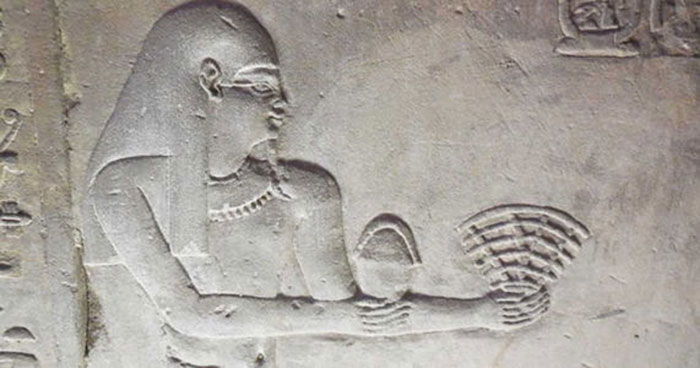 This relief carving shows a wireless antenna. The Egyptians used antennae and cable-free energy for wireless communication. In the relief on the right is a carved transmitter, with a receiver on the left. This evidence indicates that the Egyptians used free wireless energy for communication purposes.
This relief carving shows a wireless antenna. The Egyptians used antennae and cable-free energy for wireless communication. In the relief on the right is a carved transmitter, with a receiver on the left. This evidence indicates that the Egyptians used free wireless energy for communication purposes.
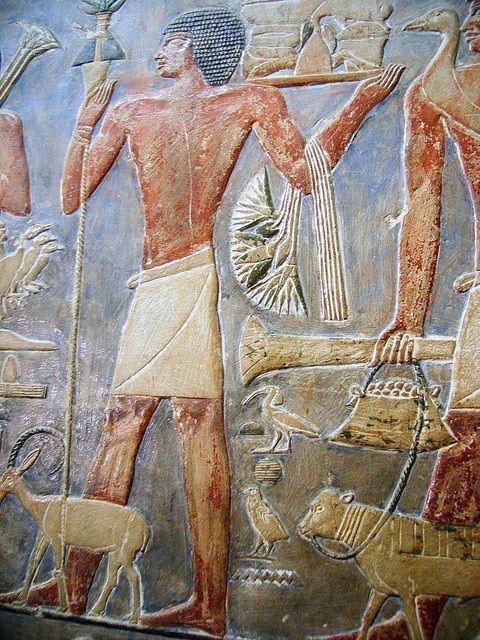 This relief carving shows a yarn manufacturing facility. The yarn Egyptians used for their fabrics at that time were as fine as those manufactured by machinery today. The Egyptians also used electric power in their weaving plants.
This relief carving shows a yarn manufacturing facility. The yarn Egyptians used for their fabrics at that time were as fine as those manufactured by machinery today. The Egyptians also used electric power in their weaving plants.
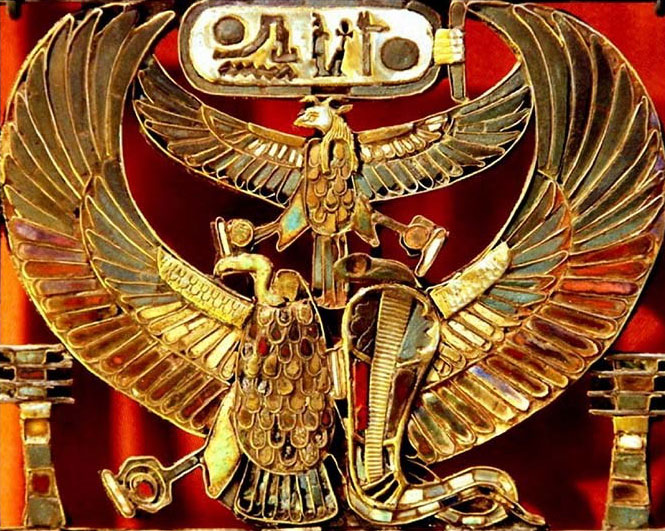 It was seen that many gold objects which have remained from ancient Egypt were in fact very finely gold plated. Such perfect gold plating, as in these pieces, requires the use of electricity.
It was seen that many gold objects which have remained from ancient Egypt were in fact very finely gold plated. Such perfect gold plating, as in these pieces, requires the use of electricity.
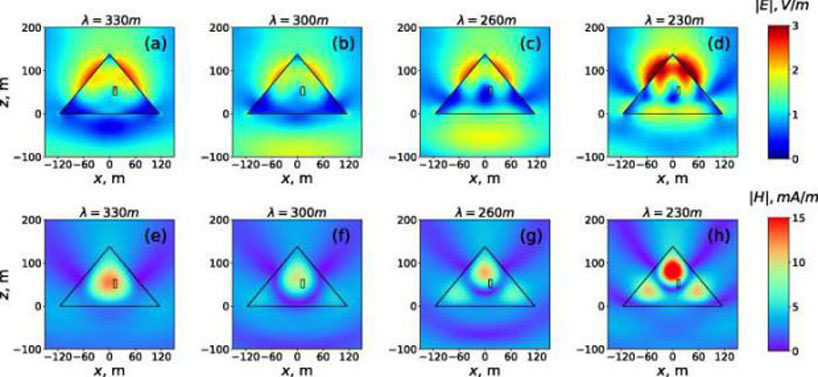 The total electromagnetic measurement made around the Great Pyramid is identical to that made during a thunder storm with lightning. There is a powerful electromagnetic field around the Great Pyramid. This may be observed through a simple experiment. When standing at the top of the pyramid with a bottle wrapped in damp cloth, sparks fly away from the bottle, as if one were on top of a high-voltage bobbin.
The total electromagnetic measurement made around the Great Pyramid is identical to that made during a thunder storm with lightning. There is a powerful electromagnetic field around the Great Pyramid. This may be observed through a simple experiment. When standing at the top of the pyramid with a bottle wrapped in damp cloth, sparks fly away from the bottle, as if one were on top of a high-voltage bobbin.
 THE PYRAMIDS WERE NOT USED AS TOMBS
THE PYRAMIDS WERE NOT USED AS TOMBS
The pyramids have always been interpreted as the tombs of the pharaohs. But in fact, no inscriptions of any kind appear in the corridors of the Great Pyramid. This suggests a functional building, rather than a mausoleum.
An empty stone chest was found on the central axis of the pyramid that archaeologists call the King’s Chamber. They claimed that this contained the coffin of the pharaoh, but since this had been stolen it was now empty. But examination of the dimensions of the stone chest and the special location in which it was installed reveals a different state of affairs. That point is just where the missing part of the pyramid’s conductive structure, and whole design, suggest it should be. If a superconductive material was installed here, the pyramid could manufacture enough electricity for all of Egypt. This superconductor is thought to have been the Ark of the Covenant, which was known to have been in Egypt in ancient times, and whose dimensions are just right to fit inside the stone chest.
The Prophet Moses was adopted by Pharaoh and, according to historic records, was raised as an administrator because of his superior moral values, intelligence and abilities. One of the phases in leadership training in ancient Egypt was the teaching of all the secrets of Egypt and the knowledge of energy. In addition to its other properties, there are also various references to the Ark of the Covenant serving as a capacitor, and that this was the source of Egypt’s energy. The Prophet Moses is known to have taken the Ark of the Covenant with him when he fled Egypt. According to historic references, one of the reasons why Pharaoh chased the Prophet Moses right up to the last moment, and strove to catch him at whatever cost, was the Ark of the Covenant because Pharaoh was aware that all the glory and magnificence of Egypt would be lost without electricity.
Historic references also show that Egyptian civilization reached its peak during the reign of Ramses II, who lived at the same time as the Prophet Moses. But those civilizations collapsed in less than 10 years after Ramses II, and Giza was even abandoned. The city, once the center of the civilization, remained deserted until the next dynasty settled there.
Were the Egyptians the only society to utilize wireless electrical technology?
The relief carvings left behind by the Mayans and the Assyrians also contain images of similar techniques to those applied in the pyramids.
All this information once again goes to demonstrate that there were no primitive people and societies in the past, as evolutionists would have us believe. In terms of civilization, more or less developed communities have lived side by side at all times throughout history. A society that existed thousands of years ago enjoyed a far more advanced technology compared to one living in the 20th century. And this shows us that development is not part of an evolutionary process, in other words, that there is no linear advancement from a primitive level of civilization to a more developed one in history.
For Further Reference (pdfs)
Lost Technologies Of Ancient Egypt
The Overall Science Behind The Pyramid
The Giza Pyramids: A History of Wireless Electricity Transmission Validated by Today’s Science
Posted in Other Topics, Science For The New Age, True History of Manwith comments disabled.


